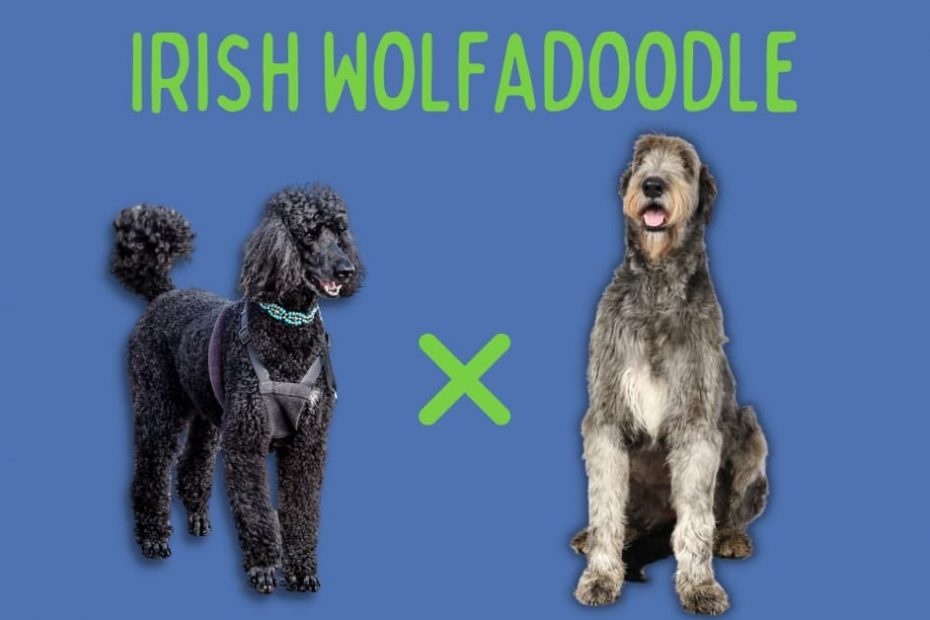The Irish Wolfadoodle is one of the tallest and most majestic of Doodle breeds.
The gentleness of the Irish Wolfhound mixed with the elegance of a Poodle makes for a Doodle breed that is truly one of a kind.
Keep reading to learn all about the Irish Wolfhound-Poodle mix!
What is an Irish Wolfadoodle?
The Irish Wolfadoodle is a Doodle breed created by crossing an Irish Wolfhound with a Poodle. The result of this crossbreed is generally a large, strong, loyal, and devoted dog that loves to please its owners. It is also known as the Irish Wolfoodle or Irish Wolfdoodle.
They tend to have the patience and laid-back nature of an Irish Wolfhound combined with the intelligence and trainability of a Poodle. Additionally, they are known for being gentle yet alert companions who make excellent family dogs.
History of the Parent Breeds
The Irish Wolfhound and the Poodle have both long and distinguished histories. The Irish Wolfhound has been bred since ancient times to be a guardian and hunter, while the Poodle was initially used as a water retriever.
Both breeds are known for their intelligence, loyalty, and trainability, making them ideal partners in life.
Irish Wolfhound: My mother’s obsession
Before diving into the Irish Wolfhound’s history, I would be remiss in telling you about my mom’s obsession with this magnificent breed.
When I was growing up, my mom would fantasize about Irish Wolfhounds. I guess she met one as a child; its giant size and sweet temperament made her fall in love. Even though she always took a particular liking to Terriers, she dreamed of owning an Irish Wolfhound.

She was always weary of buying one because she wasn’t sure if she could handle their size. Plus, as a family, we always had a house full of dogs – some planned, some by accident.
My grandpa would taunt my mom that he would buy her one. It never happened, and my mom still adores the breed. It wasn’t until I met my first Irish Wolfhound that I realized what she was talking about.
I was taking a walk in Dayton, OH, with my Bernedoodle (Murphy), and we saw a tall, regal dog that looked oddly like a wolf. He was off-leash and running at a casual pace. Both Murphy and I were a bit scared.
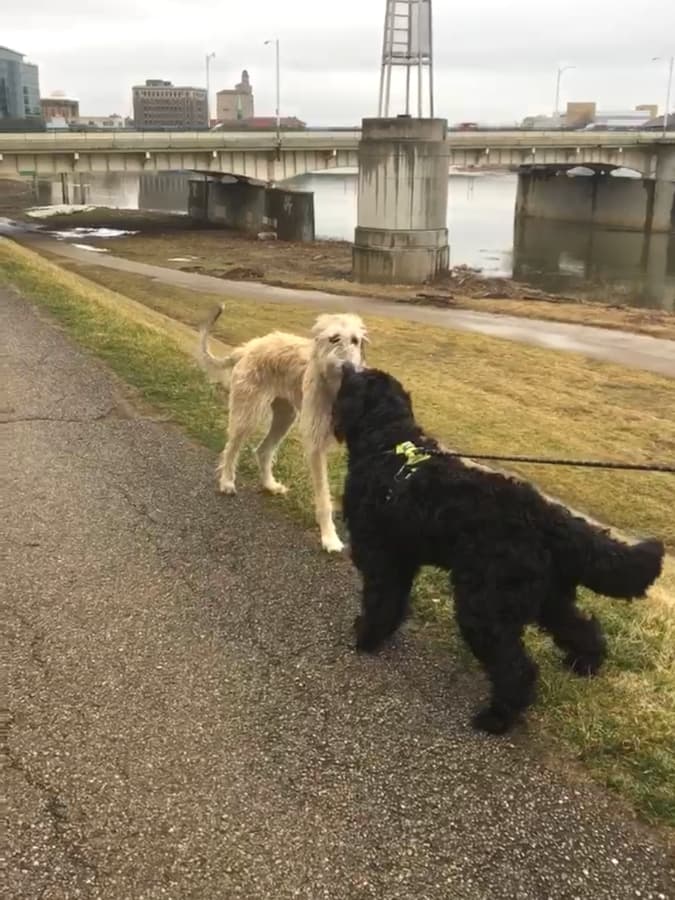
He ran up to meet us and was so sweet, not to mention gorgeous. His owner was down the way, and with one quick whistle, the Wolfhound bounded off to meet up with him.
He was majestic – a gentle pup packed into such a significant figure. Like my mom, I couldn’t help but fall in love with the gentle giant!
I’ve seen a few more Irish Wolfhounds around the trails here in Utah since. I always stop and ask the owner for a pet!
Irish Wolfhound History
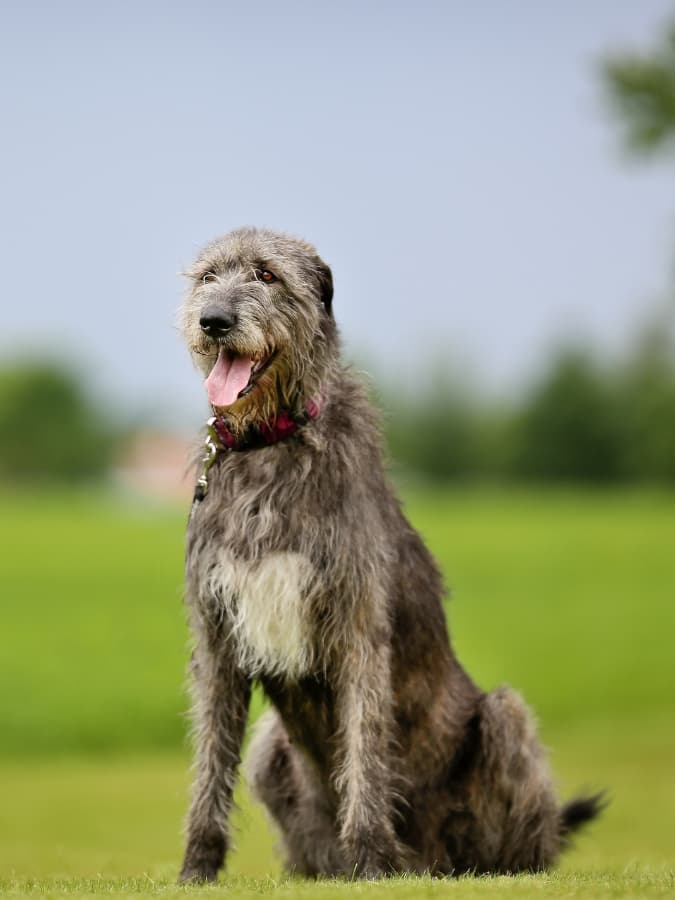
The Irish Wolfhound is a giant breed that originated in Ireland. It is believed to have been developed from ancient Celtic hounds and used to hunt wolves and other wild animals. In later years, it was also used as a guard dog, protector, and companion.
The breed has been around for centuries, with references to the dogs appearing in literature as early as the 6th century [1]akc.org/expert-advice/dog-breeds/irish-wolfhound-history-behind-the-breed. The Irish Wolfhound is still used as a working dog and kept as a family pet.
Surprisingly, the Irish Wolfhound is noted to have gone extinct in the late 1800s. However, a man named Augustus Graham made efforts to revive the breed using dogs believed to have been descended from Irish Wolfhounds, Scottish Deerhounds, and Great Danes and produced the Irish Wolfhound that the world knows today after breeding for a few generations.
The debate still goes on if the modern-day Irish Wolfhound is related to the original Irish Wolfhound or is a new breed created by humankind [2]akc.org/expert-advice/dog-breeds/irish-wolfhound-history-behind-the-breed.

The Irish Wolfhound came to America in the 19th century and is one of the most popular breeds in the United States. The Irish Wolfhound has a long muzzle, and small ears set close together.
Owners say that this breed is “gentle, sweet, and calm.”[3]youtube.com/watch?v=6U4M4zShdd4
Known for their strength, courage, loyalty, and independence, Irish Wolfhounds are intelligent dogs that make excellent companions but can also be stubborn and difficult to train.
This breed requires daily exercise, including extensive walks and lots of playtime, to stay healthy and happy [4]iwclubofamerica.org/about-irish-wolfhounds.
Poodle
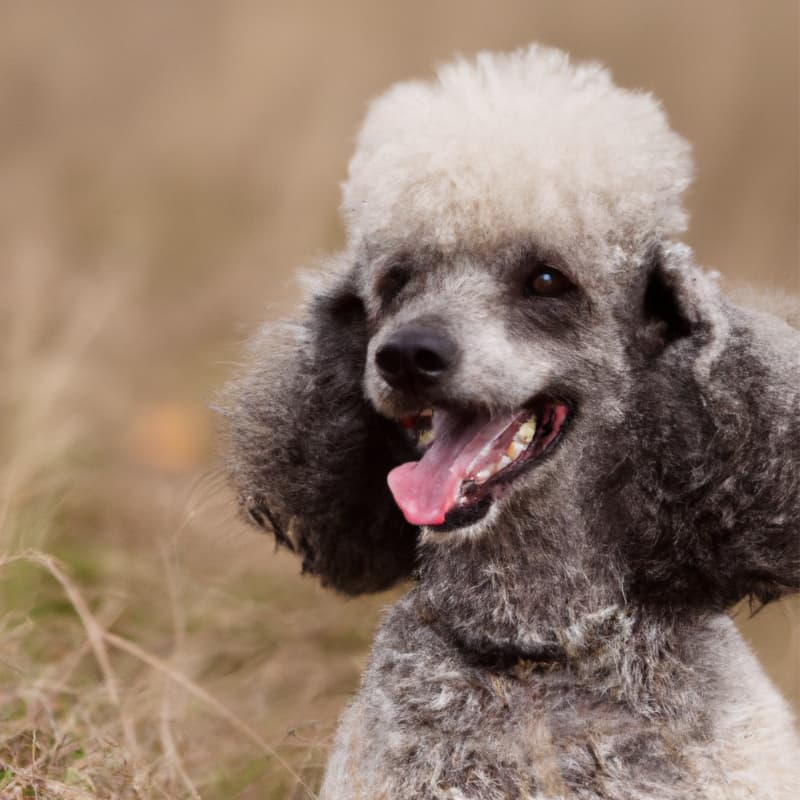
The Poodle is a breed that originated in Germany, where it was initially bred as a type of water dog. The breed’s exact origin is unknown, but it is believed to have descended from various European water dogs such as the French Barbet and German Standard Schnauzer.
The original purpose of the standard Poodle was to hunt ducks and other waterfowl. This is why the breed has a unique coat texture, which was designed to allow them to remain buoyant while swimming [5]akc.org/expert-advice/lifestyle/10-facts-about-poodles.
In the 18th century, the Poodle became popular in France among royalty and the aristocracy due to its intelligence, loyalty, and elegant appearance. These dogs were used as circus performers and became popular as a lapdog in France and the rest of Europe.
By the 19th century, Poodles had become one of the most popular breeds in Europe, and eventually, they made their way to North America in the early 19th century [6]ukcdogs.com/standard-poodle.
The Poodle is an incredibly intelligent, active, and loyal dog breed. They are highly trainable, making them popular in various performance venues, such as agility and obedience competitions. There are three sizes of Poodle – standard, miniature, and toy.
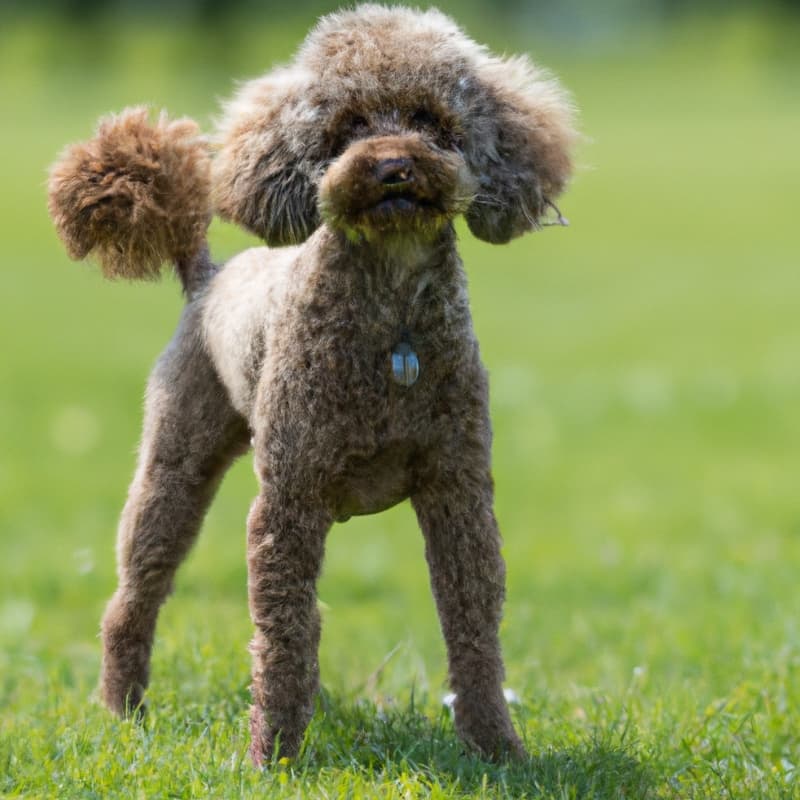
They are social animals who love to be around their families, but they can also stand to be alone if necessary.
People around the world love Poodles because they are “loyal, happy, and intelligent.”[7]youtube.com/watch?v=_Pw-39u9344
Appearance
The Irish Wolfhound is typically a short-haired breed, and its coat can range from gray, brindle, black, red, white, or wheaten.
The color of the coat depends on the individual dog’s genetic makeup. Generally speaking, these dogs have an undercoat lighter in color than the outer coat, which is usually darker.
The Irish Wolfhound also has a distinctive mane of long fur around its neck and chest, making it recognizable as a unique breed.
The Poodle is known for its unique double coat. The outer coat of the Poodle is composed of tight, curly hair that can either be corded or clipped and groomed into show clips.
This coat type helps protect them from inclement weather and prevents matting. Underneath the topcoat, there’s a downy undercoat that’s usually softer and denser than the outer coat. The Poodle coat is available in various colors, including white, black, silver, and cream.
Coat Type
A typical Irish Wolfadoodle will have an even blend between both parent coats. The coat tends to be dense and coarse while retaining the curls or waves from the Poodle side. Shedding is typically light, with minimal dander.
Coat Colors
The Irish Wolfadoodle has quite a variety of coat colors in its genes. Both the Poodle and Irish Wolfhound contribute unique colors to the genetic pool.
The parents will be the best determinant of your Irish Wolfadoodle coat.
Below is a list of possible coat colors for the Irish Wolfadoodle:
- Black
- Blue
- Brindle
- Cream
- Gray
- Red
- Silver
- Silver
- Wheaten
- White
An Irish Wolfadoodle’s coat may be one color or a mix of colors. They may have markings on their chest, feet, or head.
The Irish Wolfadoodle may also take on a unique coat pattern such as merle, brindle, tricolor, phantom, or tuxedo.
Size
Irish Wolfadoodles have a robust and muscular frame that gives off a powerful impression while also being agile and graceful in movement.
Height
Wolfadoodles measure anywhere from 20-33 inches in height in both females and males, hitting the average of their parent breeds.
Irish Wolfhounds are recognized as the tallest dog breed. They grow from 30-35 inches, with males having a minimum height of 32 inches and females having a minimum height of 30 inches [8]akc.org/dog-breeds/irish-wolfhound.
Standard Poodles grow over 15 inches in height [9]akc.org/dog-breeds/poodle-standard.
Due to genetics, sex, and environmental factors, some Wolfadoodles may be slightly smaller than others.
Weight
Irish Wolfadoodles range from 70-120 pounds.
Males reach the higher end of the average, weighing anywhere from 70-120 pounds, while females can weigh anywhere from 70-95 pounds, smaller than their male counterparts.
The weight of this breed is the sweet spot between the two parent breeds.
Male Irish Wolfhounds weigh in at an average of 120-155 pounds, with females weighing an average of 105-135 pounds [10]akc.org/dog-breeds/irish-wolfhound.
Male Standard Poodles weigh an average of 60-70 pounds, with females weighing an average of 40-50 pounds [11]akc.org/dog-breeds/poodle-standard.
Traits & Characteristics

Temperament & Personality
The Irish Wolfadoodle is known for its lively, outgoing, and confident temperament. They have strong personalities and need lots of physical activity and mental stimulation to stay happy and healthy. They are very affectionate with their family but can be a bit aloof with strangers.
This breed is known for being good with children and is eager to please them. The Irish Wolfadoodle requires early and consistent training to ensure it becomes a well-rounded adult.
They will need regular socialization with people and other animals to be confident and relaxed around others. With proper care, the Irish Wolfadoodle can make an excellent family pet.
The Irish Wolfadoodle also has a unique personality that sets them apart from other breeds. These designer dogs are known for their goofy, fun-loving attitude and intelligence.
They love to play and explore and can be quite mischievous at times. Irish Wolfadoodles may also be stubborn and independent, so patience is vital when training them. However, they are brilliant and respond well to positive reinforcement.
Common Health Issues
A purebred dog is often at risk for the common health issues found within their breed. Since Irish Wolfadoodles are a mix of two breeds, they may benefit from hybrid vigor. This refers to increased resistance to inheriting breed-specific diseases.
This does not mean that Irish Wolfadoodles are immune to disease or health issues. They are still at risk for all possible canine ailments. They’re at a slightly increased risk of diseases common to the Poodle and Irish Wolfhound breeds.
The list below highlights some health problems to keep an eye out for:
- Hip dysplasia
- Elbow dysplasia
- Cardiomyopathy
- Chronic Active Hepatitis
- Pneumonia
- Osteosarcoma (bone cancer)
- Retinal atrophy
- Von Willebrand’s disease
- Hypothyroidism
- Megaesophagus
- Addison’s disease
- Bloat
- Epilepsy
(Source: American Kennel Club)
A reputable breeder will lessen the risk of a Wolfadoodle litter inheriting health conditions by having the parents tested. Modern veterinary science enables breeders to understand the health profile of the dam and sire before breeding them.
Lastly, routine vet checkups will help keep your Irish Wolfadoodle healthy and happy!
Grooming
The Irish Wolfadoodle is a hybrid breed that combines the intelligence, loyalty, and playfulness of the Irish Wolfhound with the hypoallergenic coat of the Poodle.
This mixture results in an intelligent dog and a loving family companion. Grooming for an Irish Wolfadoodle is relatively easy compared to other breeds due to its low-shedding coat.
Brushing should be done regularly, ideally once or twice a week, to prevent tangles and mats from forming in their fur; it will also help keep the coat looking its best. A slicker brush works well for this purpose, as it can easily detangle and smooth out the fur.
Bathing should only be done if necessary since this breed is known to have sensitive skin, and bathing too often can strip the natural oils from their fur.
Toenail trimming should also be done regularly, usually, every couple of weeks, to keep the Irish Wolfadoodle’s nails at an appropriate length and prevent them from splitting or breaking.
It is essential to use a sharp nail trimmer and be careful not to cut the quick, which is the sensitive inner part of the nail that can cause pain if it is nicked.
Grooming an Irish Wolfadoodle is relatively easy but should be done regularly to keep its coat healthy and looking its best.
Diet
Feeding an Irish Wolfadoodle is similar to feeding any medium to large dog. As a hybrid, the Irish Wolfadoodle will have some nutritional needs that differ depending on which parent breed has the more dominant genes.
The amount of food your pet will need will depend on his activity level, age, and size. For example, a puppy will require more food at mealtimes than an adult Wolfadoodle. Generally speaking, an adult Irish Wolfadoodle should be fed two meals per day in equal amounts at the exact times each day.
An Irish Wolfadoodle should be fed a high-quality, nutritionally balanced high-quality dog food designed for large-breed dogs. If you choose to feed your Irish Wolfadoodle a raw or homemade diet, you must consult a vet or pet nutritionist to ensure all your pet’s dietary needs are met.
The amounts of food recommended by the food manufacturer should also be considered when determining how much to feed your pet.
In addition to a well-balanced diet, it is also essential to provide your Irish Wolfadoodle with plenty of water throughout the day. This will help them stay hydrated and healthy. Treats can be given in moderation as long as they are healthy and appropriate for the pet’s size and age.
Lifespan
The lifespan of the Irish Wolfadoodle is typically between 8 to 13 years.
Unfortunately, Irish Wolfhounds have a shorter life expectancy than other breeds, which is common in large dogs. But since Wolfadoodles are hybrid dogs, the Poodle’s genes may help increase the average lifespan.
This hybrid breed can have a longer life expectancy with proper care and nutrition. Taking your pup for yearly check-ups with a trusted veterinarian is important to stay on top of any potential health issues.
Training
Training an Irish Wolfadoodle requires patience and consistency. Start by teaching basic commands such as sit, stay, come, down, wait and let’s go. It can be helpful to use treats or other rewards during training sessions.
Positive reinforcement is the best way to train your Irish Wolfadoodle puppy. Make sure you praise them every time they do something correctly. This will help them learn faster and build a trusting bond between you and your dog.
It is important to socialize your Irish Wolfadoodle for them to get used to being around other animals and people. Take them on walks, introduce them to new places or experiences, and ensure they are exposed to various people and animals.
Obedience classes are an excellent way to train your Irish Wolfadoodle. These classes will teach them important commands and socialization skills and provide mental stimulation, which is important for this dog breed.
Are Irish Wolfadoodles good service dogs?
Yes, the Irish Wolfadoodle is a gentle giant and easy to train. With proper training, they would make for an excellent therapy dog or service dog. Since they are a larger dog, it is important to keep in mind that they may only be adequate for some service roles.
Final Thoughts
The Irish Wolfadoodle is a large breed with an equally large heart. Their calm demeanor meshes nicely with all family members.
So what are you waiting for? Time to go pick up your Irish Wolfhound-Poodle mix puppy!

References

